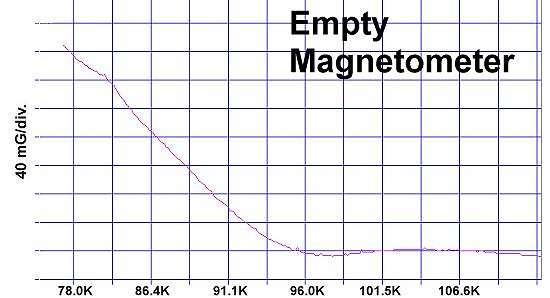



Superconductors.ORG herein reports the binary superconductor MgB2 has been successfully reformulated to BMg2Ox, increasing its critical transition temperature (Tc) from 39 Kelvin to 85 Kelvin. In the above two magnetization plots BMg2Ox displays twin Meissner transitions, suggesting reentrant behavior. Both test plots show the strongest transition near 85K, with a weaker secondary phase around 103K. Since its surprise discovery as a superconductor by J. Nagamatsu, et al, in 2001, the simple binary alloy MgB2 has seen many attempts to improve its performance through doping and substitution. However, adjusting the stoichiometry and adding oxygen have, until now, not been attempted. As a result of recent superconductor discoveries of oxides that combine one trivalent and two divalent metals, this reformulation was expected to succeed.
The below right plot shows the magnetometer trace when empty. It explains the negative slope on the left side of both test plots. Allowing for this slope, both BMg2Ox plots would have a diamagnetic transition around 190-200 milligauss, which is comparable to transitions produced by the industrial superconductor YBCO in the same magnetometer.


|

The structures of the precursor oxides are shown at left. The resulting BMg2Ox structure, while not yet determined by XRD, shows signs of nonlinearity. This was deduced by comparing its transition temperatures to those of ternary superconductors with tetragonal structures. If elements of these atomic weights were aligned collinearly, the Tc should be around 120-125K. Just as planar weight ratio directly correlates with Tc, metals being off-axis also affect Tc by reducing periodic compression of the oxygen ions. See the below illustration where boron is off-axis. 
|
The below stoichiometric amounts of chemicals were used in the synthesis of this material:
B2O3 99.98% (Alfa Aesar) 5.20 grainsThe chemical precursors were mixed, pelletized at 60,000 PSI and pre-sintered overnight at 435C. Then sintering followed at 880C for 11+ hours. After sintering the pellet was annealed for 10+ hours at 500C in flowing O2. Testing temperatures were determined using an Omega type "T" thermocouple and precision OP77 DC amplifier. The magnetometer employed twin Honeywell SS94A1F Hall-effect sensors with a tandem sensitivity of 50 mv/Gauss.
RESEARCH NOTE: These materials can be strongly hygroscopic. All tests should be performed immediately after annealing.
RE-PUBLICATION NOTICE: Elsevier Publishing, dba Elsevier Science, as well as Morris Communications, both print and broadcast divisions, are specifically prohibited from re-publishing any part of this news story.
E. Joe Eck
© 2016 Superconductors.ORG
All rights reserved.
 BACK to "News" page at Superconductors.ORG
BACK to "News" page at Superconductors.ORG